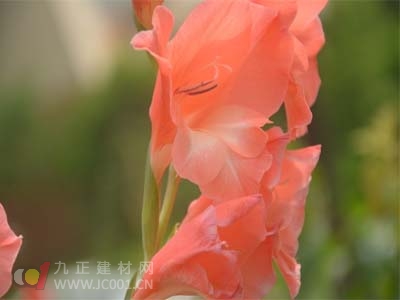Key Cultivation Techniques for Gladiolus:
1. Soil Preparation and Fertilization: Gladiolus thrives in well-drained, sandy loam soil with a deep, loose structure. Raised beds of 20 cm height and 1–1.5 m width are ideal. A balanced NPK fertilizer should be applied shallowly due to the plant's shallow root system. Apply a diluted manure solution mixed with urea during the two-leaf stage and at the heading stage. In the mid-season, apply potassium fertilizer, and reduce nitrogen later to avoid excessive growth and lodging. For bulb production, ensure sufficient potash is added to the soil.
2. Bulb Selection and Treatment: After determining the variety, choose bulbs that are pest-free and have no sprouts. Sort the bulbs by size before planting. Soak them in water for 15 minutes, then immerse in a 0.1% mercury or formalin solution (diluted 80 times) for 30 minutes. Rinse thoroughly and plant immediately.
3. Planting Time: Under natural conditions, gladiolus is typically planted between April and May when the soil temperature reaches around 10°C. For annual production, adjust planting time based on desired flowering periods. If you need flowers before New Year, plant in early September. For the Spring Festival, plant at the end of September. For early spring cut flowers, plant from late November to December. To flower between late May and early June, start seedlings in February and plant in April. For National Day blooms, plant between early June and mid-July.

4. Breaking Dormancy: To promote growth, store bulbs in low temperatures for about three months. If an earlier planting is needed, treat them with 35°C heat for 15–20 days, followed by 2–3°C for 20 days. Keep the bulbs dry during this period to prevent rotting due to high humidity.
5. Planting Spacing and Depth: The spacing depends on the plant type—20 cm square for large varieties, 10–15 cm square for smaller ones. Plant bulbs 3–10 cm deep. To prevent lodging, install two layers of 20 cm nylon mesh on the bed before planting. As the plants grow, stretch the mesh with poles to support the stems and avoid bending.
6. Flower Harvesting and Bulb Storage: Harvest the first open flower, leaving at least three green leaves at the base to allow the bulb to continue growing. Cut flowers in the afternoon and bundle them into boxes, usually 10 bundles per box. Dig up bulbs when the leaves are about one-third developed. Remove the leaves, let the bulbs dry for several hours, and then store them in a dry, well-ventilated room at 5–11°C. Separate new bulbs and offsets into shallow containers, and check regularly to prevent mold and overheating.
The Railways specialist business unit covers every stage of the process, from feasibility studies and design, through to construction, works supervision and maintenance. It offers innovative solutions and advanced materials adapted to each project, integrating construction processes and sustainable best practices. It offers proprietary technology for laying ballastless track for high-speed lines and tramways.
Subway Tunnel Trolley,Railway Tunnel Trolley,Railway Tunnel Lining Formwork,Railroad Formwork
Anshan Lijian Engineering Group Co. LTD , https://www.lijianformwork.com